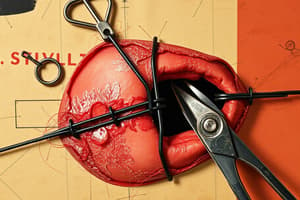Podcast
Questions and Answers
An empty bladder is required before a C-section surgery.
An empty bladder is required before a C-section surgery.
True (A)
Self-retaining catheters have either 1 or 2 channels only.
Self-retaining catheters have either 1 or 2 channels only.
False (B)
A 3-way catheter is wider and harder than other types.
A 3-way catheter is wider and harder than other types.
True (A)
Silicone catheters should be changed every week.
Silicone catheters should be changed every week.
A common complication of catheterization is urinary tract infections (UTIs).
A common complication of catheterization is urinary tract infections (UTIs).
Continuous drainage helps prevent blockages in the urinary system.
Continuous drainage helps prevent blockages in the urinary system.
Cuffed endotracheal tubes are typically used for children.
Cuffed endotracheal tubes are typically used for children.
Paraphimosis is a complication associated with catheterization.
Paraphimosis is a complication associated with catheterization.
Only one use is permitted for double lumen endotracheal tubes.
Only one use is permitted for double lumen endotracheal tubes.
The size of an endotracheal tube is determined by its internal and outer dimensions.
The size of an endotracheal tube is determined by its internal and outer dimensions.
Flashcards are hidden until you start studying
Study Notes
Suture Types
- Monofilament Sutures: Composed of a single strand; they are less likely to harbor organisms and are ideal for vascular surgery.
- Multifilament Sutures: Made of multiple filaments twisted together, providing greater tensile strength.
Tensile Strength
- Refers to the strength required to hold tissues in proper apposition during surgical procedures.
Types of Stitches
- Simple Stitch: Basic form of suturing.
- Mattress Stitch:
- Vertical mattress: Provides good tissue apposition.
- Horizontal mattress: Used for tension relief.
- Lembert Suture: Involves two rows of sutures; the first row goes all the way through, while the second row inverts the tissue.
- Tension Suture: Enhances tissue apposition in areas requiring extra support.
Suture Removal Guidelines
- Timing of suture removal depends on the anatomical location:
- Face: 5-7 days
- Scalp: 10 days
- Trunk & Upper Extremities: 10-14 days
- Lower Extremities: 14-21 days
- Prompt removal minimizes the risk of suture marks, infection, and adverse tissue reactions.
Suture Techniques
- Skin Preparation: Clean and sterilize before suturing.
- Suture Removal Technique: Gently elevate with forceps, cut one side, and pull toward the suture line.
Suture Accessories
- Steri-Strips: Used for small skin closures.
- Staplers: Used to quickly close wounds.
- Tissue Adhesive: Alternative to sutures for closing wounds.
- Barbed Sutures: Provide secure closure without knots.
Suture Needles Types
- Straight Needles: Suitable for superficial structures, like skin.
- Curved Needles: Available in various arcs (3/8, 1/2, 5/8 of a circle) for deeper penetration.
- Rounded Needles: Circular cross-section used for organs and mucosa.
- Cutting Needles: Triangular cross-section for tougher tissues such as skin.
- Eyeless Needles: Incorporate the thread within the needle, used in plastic and vascular surgeries.
- Eyed Needles: Feature an opening for threading and limited reuse.
Surgical Operations Overview
- General Anesthesia: Commonly used for extensive procedures.
- Incision Techniques: Specific techniques depending on body area (e.g., transverse for the neck, semilunar for the cheek).
Abscess Management
- Cold Abscesses: Treated with anti-TB drugs; aspiration is preferred over drainage.
- Drainage Guidelines: Indicated for secondary pyogenic infections or impending rupture.
Types of Drains
- Classification:
- Open vs Closed
- Active vs Passive
- Uses:
- Fluid withdrawal
- Tissue apposition to eliminate potential spaces
- Drain Types:
- Corrugated Drain: Keeps track of shortening daily.
- Passive Open Drain: Simple gauze dressing for abscesses.
- Closed Passive: Similar to T-tube for controlled drainage.
- Closed Active: J-Vac system for suction.
Drain Functions and Considerations
- Insertion Purpose: To evacuate pus, blood, or fluid collections.
- Advantages:
- Reduces infection risk
- Prevents fluid accumulation
- Early detection of leaks or hemorrhages
- Disadvantages:
- Increased infection risk
- Potential for mechanical damage or leaks
- Drains may become infective quickly.
Specific Tubes and Catheters
- NG Tube:
- Used for stomach decompression and long-term feeding.
- Indicated for aspiration prevention and poisoning treatment.
- Orogastric Tube: Employed for massive upper GI bleeding and traumatic cases.
- Foley Catheter: Used for bladder drainage, monitoring, and surgeries.
- Complication Management: UTI prevention through continuous drainage and regular changes.
Endotracheal Tube Types
- Cuffed/Uncuffed Options: Cuffed tubes protect against aspiration in adults; uncuffed for children.
- Usage Considerations: Ideally single-use; variations include double lumen and reinforced types.
Studying That Suits You
Use AI to generate personalized quizzes and flashcards to suit your learning preferences.




